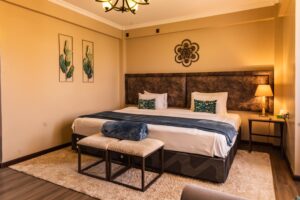Hotel rooms are categorized using several criteria, including the room size, the expected length of stay, and the types of services provided, such as hotel breakfasts.
Types of Hotel Rooms Based on Occupancy
Many hotel rooms are categorized based on the expected number of occupants.
Single Room
A single room is generally small and is intended for single occupancy. It will typically have one single-sized bed, although some single rooms are equipped with additional sleeping facilities or may have a second bed added if required. True single rooms are declining as hotels find it more efficient to offer twin rooms.
Twin Room
A twin room is essentially the same as a single room but comes with two beds instead of one. They are generally lower than double rooms, making them an inexpensive option for two guests traveling together. If necessary, an additional bed can be added with a corresponding charge.

Double Room
A double room is intended for two people. Instead of two single beds, it will have a larger double bed intended for two people, typically queen or king-sized. This type of room is best for couples (or people who don’t mind sharing a bed).
Triple Room
Triple rooms are large enough to sleep three people comfortably. There will be two to three beds. These might be a combination of one double and one single bed, two double beds, three single beds, etc. Triple rooms are ideal for small groups or families — for example, two parents and a child.
Quadruple Room
A quadruple or quad room is a larger room intended for four guests. The arrangements in these types of hotel rooms can vary. A room for families with children might offer two double beds or one double bed and two singles. Alternatively, quad rooms may use four single beds or four dormitory-style bunks.
Types of Hotel Rooms Based on Bed Type
Some hotels classify rooms by the number or size of the beds in the room. However, guests should note that hotels still have restrictions on how many guests are allowed per room. Just because there’s a king bed in a room, doesn’t mean you can invite 15 people to stay. Occupancy limitations make this a liability for the hotel. Many hotels will charge more for extra guests (to a certain limit) or allow for you to add a cot to a room with an odd number of people.
Here are some room types determined by bed availability:
Queen: a room with a queen-sized bed.
King: a room with a king-sized bed.
Twin: a room with two twin-sized beds.
Studio: Some studios come with additional beds. Others come with more space: a studio room can be like a fully-furnished apartment, meaning it will have a small kitchenette. Check with the hotel to learn more about their studio rooms.
Types of Hotel Rooms Based on Room Layout
Rooms can also be categorized based on their arrangement and the facilities offered.
Studio Room
A studio room offers all the amenities of a small apartment, plus a studio bed. This convertible bed can be turned into a sofa or furniture. A studio room is ideal for longer-term stays.
Duplex
A duplex suite comprises two rooms on separate floors, with a private staircase or lifts between them. A duplex is a good choice for a guest such as a business traveler who wants to work or hold meetings in one room and sleep in the other.
Deluxe Room
A deluxe room will generally be larger and more lavishly appointed than other hotel rooms. They will often have additional features such as a whirlpool bath, a private patio or balcony, or a particularly outstanding view. The cost will also be higher.
Adjoining Room
Adjoining rooms are next to each other and feature connecting doors. They will also have separate entrances to the main corridor. Adjoining rooms are ideal for groups who require separate sleeping spaces at night but who want a single larger space during the day.
Connecting rooms
Rooms with separate entries from the outside and a connecting door between the rooms so guests can move between rooms without going out into the hallway. Great for families or groups.
Apartment-Style Room
Apartment-style rooms are designed for longer stays. They are arranged so guests can prepare meals and enjoy a comfortable stay. Housekeeping services are typically restricted to two or three visits a week. This type of room offers a comfortable home away from home.
Suite
Suites typically have two or more rooms, at least one bedroom, and a sitting area. Less commonly, a suite may be a larger room with distinct sitting and sleeping sections. A suite usually aims at more affluent customers and commands a higher price; the upscale amenities will reflect this.
Junior Suite
A junior suite is smaller than a standard suite. It may incorporate two smaller rooms or use a one-room layout with distinct areas for sleeping and living. The layout will vary between establishments. A junior suite will be well-appointed and offer upscale amenities.
Presidential Suite
As its name implies, a presidential suite will be more impressive than a standard suite. Only an extremely luxurious hotel will have more than one or two such suites available. They are important for hotel marketing strategies. A presidential suite will consist of multiple rooms with opulent furnishings and amenities.
Penthouse Suite
A penthouse suite often takes up one entire hotel floor, usually the topmost. The height of luxury, penthouses are among the most exclusive (and expensive) types of suite. They are often accessed by a separate private lift that requires a key card to enter.

Bridal Suite
A bridal suite is usually large with big, open rooms. Bridal suites will typically have flexible facilities and work areas for wedding preparations to accommodate a bride and her party as they prepare for the ceremony. Hotels with bridal suites often specialize in catering for wedding groups.
Honeymoon Suite
A honeymoon suite is a romantic suite that comes with special services aimed at newlyweds. Champagne and roses might be provided, as well as private dining options and other romance-themed services such as couple’s activities and excursions.

Cabana
A cabana is a hotel room that opens onto a beach or a swimming pool. Sometimes, the pool may be private and reserved only for the guests in that room. Cabanas are usually furnished in a luxurious style. Some have private balconies that allow beach access.
Villa
A villa is distinct from conventional types of hotel rooms. It’s a private hideaway that’s usually detached from the main hotel. Villas are usually located in a picturesque part of a hotel’s environs and offer seclusion for affluent travelers. Villas may be on the hotel grounds or in a scenic location nearby.
Difference Between Single Occupancy and Double Occupancy
Single occupancy and double occupancy refer to the number of guests staying in a rented hotel room.
Single Occupancy: This term means that only one person will be staying in the room. The rate is based on one individual’s use of the room, and no additional guests are expected.
Double Occupancy: In contrast, double occupancy means that two people will be sharing the room. The double occupancy rates are designed to cover the cost of two individuals using the facility. If more than two people end up staying, the hotel policy may require an additional fee.
CONCLUSION
There are lots of different types of hotel rooms available for modern travelers to choose from. Some hotels offer standard king or double rooms only, whereas others offer all-suites or apartment-style living. While some hotel rooms are pet-friendly or allow smoking, others do not. Suite rooms tend to include a kitchen area, whereas standard rooms do not. There’s now a room type out there to fit just about every style, and new hotel room types are evolving all the time.
